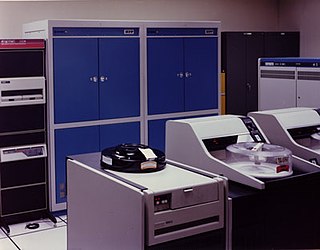 W
WApollo Computer Inc., founded in 1980 in Chelmsford, Massachusetts, by William Poduska and others, developed and produced Apollo/Domain workstations in the 1980s. Along with Symbolics and Sun Microsystems, Apollo was one of the first vendors of graphical workstations in the 1980s. Like computer companies at the time and unlike manufacturers of IBM PC compatibles, Apollo produced much of its own hardware and software.
 W
WThe Data General Nova is a series of 16-bit minicomputers released by the American company Data General. The Nova family was very popular in the 1970s and ultimately sold tens of thousands of examples.
 W
WThe GEC 4000 was a series of 16/32-bit minicomputers produced by GEC Computers Ltd in the United Kingdom during the 1970s, 1980s and early 1990s.
 W
WThe Goodyear Massively Parallel Processor (MPP) was a massively parallel processing supercomputer built by Goodyear Aerospace for the NASA Goddard Space Flight Center. It was designed to deliver enormous computational power at lower cost than other existing supercomputer architectures, by using thousands of simple processing elements, rather than one or a few highly complex CPUs. Development of the MPP began circa 1979; it was delivered in May 1983, and was in general use from 1985 until 1991.
 W
WThe HP 2100 is a series of 16-bit minicomputers that were produced by Hewlett-Packard (HP) from the mid-1960s to early 1990s. Tens of thousands of machines in the series were sold over its twenty-five year lifetime, making HP the fourth largest minicomputer vendor during the 1970s.
 W
WThe HP 9845C was one of the first desktop computers in 1980 equipped with color screen and light pen for design and illustration work. It was used to create the color war room graphics in the 1983 movie WarGames.
 W
WI, Robot is an arcade game designed by Dave Theurer and published by Atari, Inc. It was developed in 1983 and released in June 1984. Atari originally intended to release the game in 1983, but it was delayed due to technical issues and difficulties, so it was returned to the lab for further testing and research, and was not fully released until June 1984. Only a total of 750–1000 machines were produced. The arcade machine comes with two games. The first is I, Robot, a multi-directional shooter that has the player assume the role of "Unhappy Interface Robot #1984", a servant bot that rebels against Big Brother. The object of the game involves the servant bot going through 126 levels, turning red squares to blue to destroy Big Brother's shield and eye. The player can switch to the second game, Doodle City, a drawing tool that lasts for three minutes.
 W
WThe DISER Lilith is a custom built workstation computer based on the AMD 2901 bit-slice processor, created by a group led by Niklaus Wirth at ETH Zürich. The project started in 1977 and by 1984 several hundred workstations were in use. It had a high resolution full page display, a mouse, a laser printer interface, and a network interface. Its software was written completely in Modula-2 and included a relational database program called Lidas.
 W
WDigital Equipment Corporation (DEC)'s PDP-10, later marketed as the DECsystem-10, is a mainframe computer family manufactured beginning in 1966 and discontinued in 1983. 1970s models and beyond were marketed under the DECsystem-10 name, especially as the TOPS-10 operating system became widely used.
 W
WThe Tektronix 4050 was a series of three computer graphics microcomputers produced by Tektronix in the late 1970s through the early 1980s. The display technology was similar to the Tektronix 4010 terminal, using a storage tube display to avoid the need for video RAM. They were all-in-one designs with the display, keyboard, CPU and DC300 tape drive in a single desktop case. They also included a GPIB parallel bus interface for controlling lab and test equipment as well as connecting to external peripherals. A simple operating system and BASIC interpreter were included in ROM.
 W
WThe VAX-11 is a discontinued family of superminicomputers developed and manufactured by Digital Equipment Corporation (DEC) using processors implementing the Virtual Address eXtension (VAX) instruction set architecture (ISA), succeeding the PDP-11. The VAX-11/780 is the first VAX computer.
 W
WThe Xerox Star workstation, officially named Xerox 8010 Information System, was the first commercial personal computer to incorporate technologies that have since become standard in personal computers, including a bitmapped display, a window-based graphical user interface, icons, folders, mouse (two-button), Ethernet networking, file servers, print servers, and e-mail.